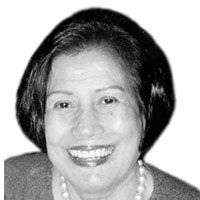Requiem for plant physiologist

January 30, 2007 | 12:00am
 This morning, necrological services will be held at the National Academy of Science and Technology in Taguig, Rizal, at 10 o’clock, for Dr. Jose R. Velasco, one of the Philippines’ national scientists, who passed away last week.
This morning, necrological services will be held at the National Academy of Science and Technology in Taguig, Rizal, at 10 o’clock, for Dr. Jose R. Velasco, one of the Philippines’ national scientists, who passed away last week.
An article written by Ila Virginia C. Ongkiko in the book Filipino Heroes of Science talks about Dr. Velasco’s contribution as a major influence in the development of the scientific method in his fields of expertise. The scientist had been particularly cited for his work on the mysterious cadang-cadang, a disease that made coconut trees die. After 40 years of study and research, he concluded that the disease was not caused by a virus, but by either a lack of mineral in the soil needed by the coconut, or toxicity in the soil caused by an element like aluminum or strontium.
In 1983, Dr. Velasco was elected to the National Academy of Science and Technology as member. On March 24, 1998, he was conferred the rank and title of National Scientist by then President Fidel V. Ramos for his outstanding achievements in plant physiology, not only on the coconut, but also on rice photoperiodism. This is the highest honor the Philippine government can give a Filipino man or woman of science.
Pepe was born on Feb. 4, 1916 in Imus, Cavite. The modest income of his father, a civil employee of the US Army, only allowed him to attend the Philippine School of Commerce in Manila to learn practical skills such as typing and shorthand so he could find a job after high school and work his way through law school. After a year, convinced he had no talent for stenography, he moved to the Central Luzon State University in Munoz, Nueva Ecija, where for three years he studied and work the fields under the hot sun. He graduated as salutatorian of his class. But he did not want to be a farmer.
For college, he was sent to the University of the Philippines College of Agriculture (UPCA) in Los Baños, Laguna, and he graduated cum laude in 1940 with a bachelor of science in agriculture, major in agricultural chemistry.
He taught at the UPCA department of plant physiology for many years. Then he studied at the University of California at Berkeley as a US Department of State scholar for one year (1946-47) and as a UP Fellow for another two years (1947-49). In a record three years he finished the Ph.D. program, returning to Los Banos in 1949 with a doctor of philosophy in plant physiology.
Until 1965, he served UPCA as research professor, director of research, director of instruction, chair of the department of botany, and editor of the Philippine Agriculturist (the college’s scientific journal).
In 1965 he transferred to the main UP campus in Diliman, Quezon City where he taught botany and managed the UP Land Grant. Two years later, he left teaching to serve the Philippine government as commissioner of the National Institute of Science and Technology (NIST), a post he held for 10 years. Even as he was administrator, he continued to work in the NIST laboratories on different research projecs.
As a teacher, Dr. Velasco is remembered by his students as "strict," forcing them to think and analyze. He was quoted as saying that students "should not study only subject matter. Rather, hand in hand with learning the subject matter, a student should develop synthesizing power. This is why teachers should exercise the integrating capacity of their students."
Dr. Velasco wrote more than 50 scientific papers, articles, reports and books, much of them about his research on cadang-cadang. He wrote the history of NIST.
He received two outstanding alumnus awards – two times from the Imus Elementary School (1981 and 1991) and the Outstanding Imus Awards in 1996.
Dr. Velasco is survived by his wife, the former Felicidad Ibanez, a school teacher from Luisiana, Laguna. They have eight children and 16 grandchildren.
His children have set their own high scholastic records – after their father’s. Dolores, a statistician, is retired from the World Bank. The late Victor Hugo was an economist, as is his wife, Lourdes. Vladimir is based in Los Angeles, Ca., where he is manager of Malaysian Airlines for North America. Jaime, a veterinarian, lives with his Mexican wife, Gloria, in the US. Jose is a retired rear admiral of the Philippine Navy, and his wife Cecille, is a real estate sales person.
Marie is a chemist, and her husband Eli is an economist with the Bank for Industrial Settlements. Rey is chancellor of UPLB, where his wife Theresa, is a development communication professor. The youngest, Vernon, is a statistician at UPLB, and his wife, Ilene, is a nurse.
For information on the book, one may contact the National Academy of Science and Technology Philippines, 2F Philippine Science Heritage Center, DOST Complex, Bicutan, Taguig, Metro Manila 1631; or email [email protected]; [email protected], or log in at http://www.dost.gov.ph/nast
BrandSpace Articles
<
>
- Latest
- Trending
Trending
Latest




























